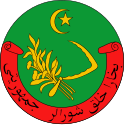Emblem of Uzbekistan
| Emblem of Uzbekistan | |
|---|---|
 Emblem of Uzbekistan | |
| Versions | |
 With cyrillic text | |
| Armiger | Republic of Uzbekistan |
| Adopted | July 2, 1992 |
| Supporters | Khumo |
| Motto | O‘ZBEKISTON |
The state emblem of Uzbekistan was formally adopted on July 2, 1992, by the newly establish
The coat of arms displays the natural wealth of the country. On the left there is a
It is surmounted by the blue star of
profess.In the center, a right-facing
The Khumo is perched on a banner at the base of the cotton and wheat borders which bears the national colors and the name of the country in Latin script (Oʻzbekiston).
Karakalpakstan, an autonomous republic within Uzbekistan uses an emblem based on Uzbekistan's, but featuring the regional colors blue, gold, and green. It features only one river, the Amu Darya, along with a local monument at the background of the emblem, adjacent to the mountains.
History
Prior to the October Revolution and the subsequent establishment of the Soviet regime in the country, the local khanates and emirates such as the Emirate of Bukhara and the Khanate of Khiva that gave way to the Uzbek Soviet Socialist Republic, lacked the coat of arms in the western sense of the word, with the local states using more traditional ways of self-representation and symbols of governance.
Bukharan People's Republic

On September 1, 1920, the
14 September 1920 marked the date when a republican form of government was adopted and all the related government institutions were established. On October 8, during the All-Bukharan Kurultai, formation of the Bukharan People's Soviet Republic was announced, followed by an adoption of a constitution on 23 September of the next year, by the same congressional body, the kurultai.

The 78th Article of the constitution of Bukharan P.S.R. was as follows:
The Government emblem of the Bukharan People's Soviet Republic consists of a depiction of a green sheaf of dzhugara with a golden sickle thrust into it on the red background. At the upper part of the emblem, a sickle of a half crescent is placed above the sheaf, inside of which is a golden five-pointed star. The sheaf itself is surrounded by the inscription of "Bukharan People's Soviet Republic".
— Central Government Archive of the Republic of Uzbekistan.
Uzbek S.S.R

On 13–15 February 1925, in the city of Bukhara, the first Uzbek Congress of the Soviets issued a declaration about the establishment of the Uzbek Soviet Socialist Republic. And 22 June 1925, the Central Executive Committee of the Soviets of the Uzbek SSR adopted a resolution No.67 Concerning the emblem and the flag of the Uzbek SSR, which temporarily, until the establishment of the Constitution of the Uzbek SSR. established the emblem of the republic.
The project of the emblem taken as basis of the final design consisted of depictions of uraq
In 1927–1928, a series of reforms were made to change the writing system of the Uzbek language into a Latinized alphabet, known as

On July 11, 1939, a decree was issued by the Central Government of the Soviet Union, as to alter the alphabets of several republics within the union into the cyrillic script. Thus, on 8 May 1940, the Uzbek script was changed from Latin alphabet, into the new Cyrillic one, based on Russian. On 16 January 1941, the emblem of the republic followed suit, and it too, switched its inscription from Latin script to Cyrillic. Hence, the coat of arms got a new insignia of «Ӯз.С.С.Р.» in the place of the old Latin one.

Further down the line, in the
Government Emblem of the Uzbek Soviet Socialist Republic consists of the hammer and sickle in the rays of sun, surrounded by a wreath, on the right consisting of ears of wheat and on the right, of a branch of cotton plant with flowers and open buds of cotton. On the top of the emblem is a five-pointed star and at the bottom, a part of the world globe. On the ribbon of the wreath are the inscriptions; Uzbek on the left: «Бутун дунё пролетарлари, бирлашингиз» and Russian on the right: «Пролетарии всех стран, соединяйтесь!». At the bottom of the two ribbons is the inscription «Ўз.ССР».
—Constitution of the Uzbek SSR (1978)
This version of the emblem survived until the
Post Independence
The current state emblem of
The symbolism
In the centre of the emblem depicts
In the upper part of the emblem is an octagon, symbolizing the unity and the confirmation of the republic. The crescent and star inside the eight-pointed star are the sacred symbols of Islam.
The image of the sun symbolizes the light that illuminates the path of the Uzbek state, whilst the flourishing valley emphasizes the unique and favorable natural and climatic conditions of the Republic.
Two rivers, run through the valley, representing the
The ears of wheat are the symbol of bread, and mark the wealth and prosperity of the republic, with open cotton boxes characterizing the previously vital cotton industry of Uzbekistan. Together, wheat and cotton boxes entwined with ribbon of the tricolor of national flag, symbolize the consolidation of the peoples living in the Republic.[2]
Gallery
-
Presidential Seal of Uzbekistan
-
An Uzbek passport with the national emblem displayed on the front
-
The Soviet Emblem in the Latin script, during a parade in Moscow
-
A Soviet stamp with the Emblem of the Uzbek SSR
References
- ^ "Гербы узбекистана".
- ^ a b c "Arms". Archived from the original on 2022-08-15. Retrieved 2020-09-11.





